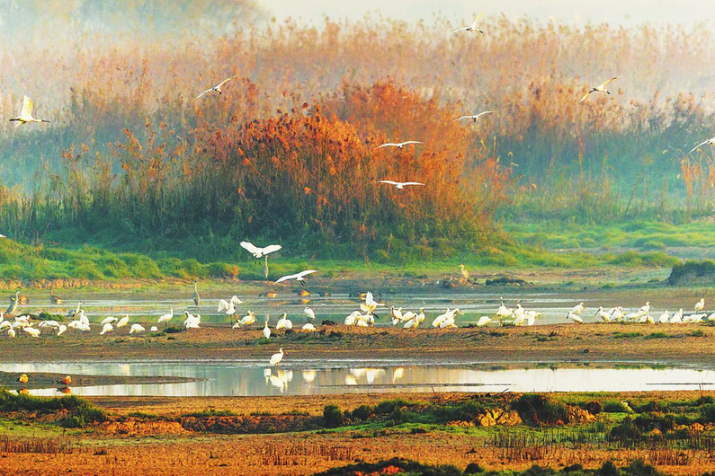I'm from Xinjiang

| Kurbanjan Samat photographs his subjects in many different settings. Parhat Alimjan, left, started a folk rock band after graduating from university; Zhang Zhiqiang of the Han ethnic group was brought up in a Uygur family and now, as a Muslim, prays five times a day; and Yakupjan Abdusamat, 27, is a Uygur who runs a jade shop in Shenzhen. Photos by Kurbanjan Samat |
| Kurbanjan Samat works on his project of photographing 120 Xinjiang people who live elsewhere in the country and getting their stories. Xiao Wei / For China Daily |
A Uygur photographer wants to tell the stories of the Xinjiang people, who simply want to live, survive and hopefully thrive just like everybody else, he says
Kurbanjan Samat started working on his photography project "I am from Xinjiang" late last year, documenting the everyday lives of the people from the Xinjiang Uygur autonomous region who are living elsewhere in the country. He hoped to capture their hopes, dreams and ambitions, proving that this often maligned group are no different from anyone else.
But after the terrorist attack at Kunming Railway Station on March 1, in which 29 people were killed and more than 130 were injured, Kurbanjan's project has taken on a new urgency.
There has been a fear and distrust of people from Xinjiang ever since the terrorist attack, which police say was orchestrated by Xinjiang separatists.
The community police in Beijing called Kurbanjan 12 hours after the attack, asking him when he was leaving.
"Why should I leave? This is my home!" he says, still irritated and angry when recounting the incident.
His plan is to photograph 120 people from the Xinjiang Uygur autonomous region and get their stories and then publish them in a book and stage an exhibition, as early as in June, if possible.
A cameraman for Central China Television's Documentary Channel, he has lived in Beijing for eight years, and he met his wife Gulbanum, a Beijing-born Uygur, in the capital.
He and his wife are sitting in a cafe in Beijing's Qijiayuan Diplomatic Compound, near the office where Kurbanjan has just finished taking photos of interviewee No 45.
"Sorry, I've smoked much more since March," says the 31-year-old Uygur, lighting a cigarette. "It used to be one pack every two days, but now I'm smoking almost two packs a day."
About two weeks after the attack in Kunming, hundreds of pedestrians and shoppers on Chunxi Road in Chengdu, Sichuan province, panicked when someone yelled a "warning" about a knife attack. The panic was sparked when some pedestrians, upon seeing a group of ethnic people on the street, starting walking faster to get away from them. The innocent ethnic group were scared at seeing people around them fleeing and they started running too.
"That was ridiculous," says Gulbanum.
"Bitter, I'd say," Kurbanjan responds, with a frown.
The two incidents prompted Kurbanjan to speed up his project - he started meeting his interviewees late last year, as originally he wanted to do a documentary on Xinjiang people who are earning a living outside the region.
"I told myself that I have to accomplish this within three months. I must let the public know what these Xinjiang people are doing," he says. "Who are Xinjiang people? It's not an ethnic concept. No single group alone can represent Xinjiang, and there is no boundary between the groups."
There are 21.8 million people from 47 ethnic groups inhabiting the region. The 13 main groups are Uygur, Han, Kazak, Hui, Mongolian, Kirgiz, Xibe, Tajik, Ozbek, Manchu, Daur, Tatar and Russian.
"There are similar projects, operated by official departments or other individuals, but I am the one who will do the job best," Kurbanjan says. "Because I am one of them. I will tell them about my story and my life first. They will echo my feelings. They will understand why I am doing this."
At first Kurbanjan was going to ask his interviewees the "grand" question, about what the Chinese Dream means to them, but he soon realized the answers were not that "grand".
"They share their stories with me. They are just ordinary people living an ordinary life, but their stories touch me," he says.
A couple want their baby to be safely delivered; a graduating student wants to find a job without being discriminated against; a canteen boss says he hopes his son who is ill will recover soon.
Kurbanjan says to live, survive, and hopefully thrive, is the common dream of Xinjiang people, and probably every Chinese.
"Why are we here? We like the opportunities the cities offer. Like here in Beijing, no matter if you are Han or Uygur, you can enjoy a decent life if you have talent," he says.
Kurbanjan came to Beijing in 2006 to study auditing at the Communication University of China after he participated in the making of the documentary Song of Forest with his mentor, Meng Xiaocheng.
Meng and his wife Li Xiaodong, who both graduated from the university, hired Kurbanjan as their assistant in 2004, when they met the then 22-year-old at a market in Hotan selling jade and discovered he was passionate about photography.
"At first we took two young men with us to the desert to document the life of diversifolious poplars. One left by himself three months later because the life was too hard and the progress was slow. But Kurbanjan stayed," Meng says.
The couple later took Kurbanjan to Beijing when the filming was completed and recommended he study at the school.
Kurbanjan became a cameraman with CCTV after winning a diploma from the school in 2008. His recent work includes filming the food of Hotan for the second season of documentary series A Bite of China.
"He is hard working and persistent, and has made much progress in his photographic career through the years," Meng says. "And although he is still a quick-tempered man, he is already much milder than he used to be."
Now Kurbanjan is on a tight schedule, traveling around the country photographing his subjects. He has interviews lined up in Shaanxi, Fujian, Shanghai, Jiangsu, Guangdong, Chongqing, Tianjin, Hebei and Gansu.
"I don't want them to pose for me. I take their pictures in their homes or while they work. I want their true stories, in a natural way," he says.
"My friends say that I'm a high-profile person and do things in a high-profile way," he adds, "It's true. I want the world to know more about Xinjiang and Xinjiang people. I'm doing this for my hometown and my people, and me."
guoyali@chinadaily.com.cn
(China Daily Africa Weekly 05/02/2014 page28)
Today's Top News
- Jimmy Lai found guilty of colluding with foreign forces
- Hong Kong court opens session to deliver verdict on Jimmy Lai's case
- China's economy posts steady growth in Nov
- Death toll rises to 16 in Sydney's Bondi Beach shooting
- Firm stance on opening-up wins praise
- World looks to new engines for growth in 2026
































